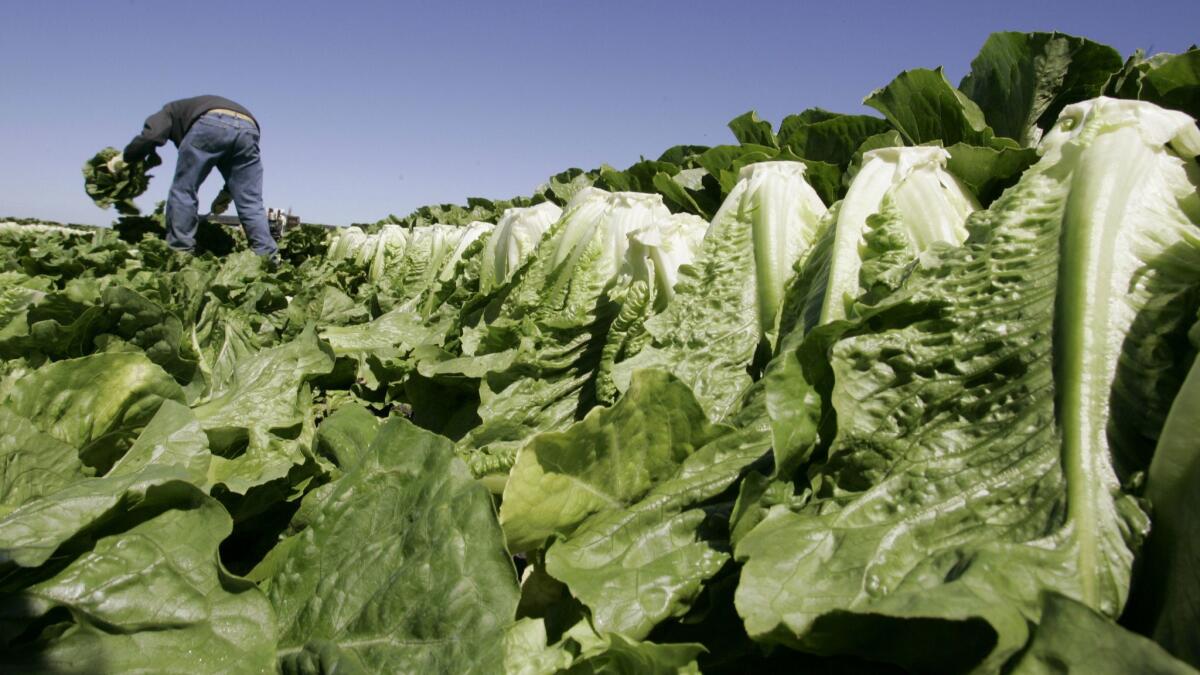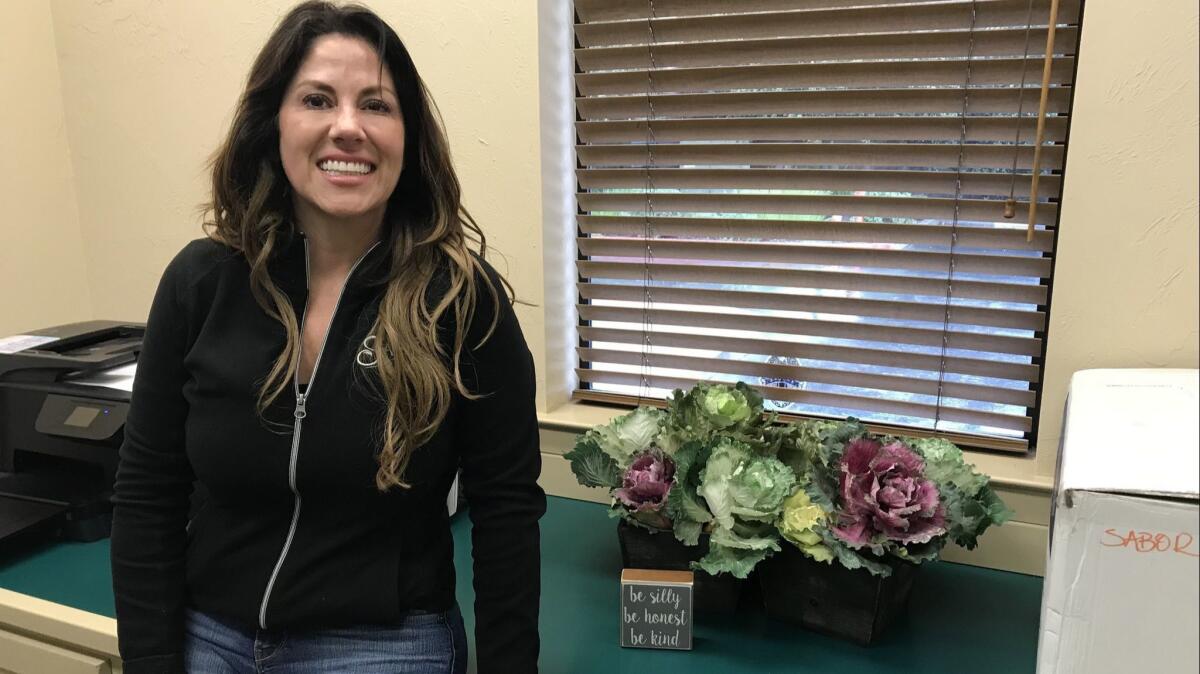Column: For some romaine farmers on California’s Central Coast, the E. coli scare is a maddening mystery

- Share via
Reporting from Salinas, CALIF. — Californians know a lot — or think they do — about our Central Valley’s crops and their controversies.
In our most recent drought, for instance, everyone became an instant “expert” on the pros and cons of almond trees, and their irrigation needs. Almonds, ridiculously, became the scapegoat of the water shortage.
But people know a lot less about the farm operations of our Central Coast, the “salad bowl of America,” where lettuce and spinach flourish, along with the specialty crops — arugula, escarole, endive, bok choy, frisee, parsley, cilantro — that farmers in the Salinas Valley call “the chimichangas.” (You won’t find that definition in any dictionary, by the way.)
Few city dwellers understand that growers of leafy green vegetables divide their lives between two places 500 miles apart.
They spend the spring and summer growing in central coastal California — in Monterey, San Benito, San Luis Obispo, Santa Barbara, Santa Cruz or Ventura counties — where winters are too cold for leafy greens.
From about Thanksgiving to Easter, like the snowbirds, they move south to Yuma, Ariz., the Imperial Valley or the Coachella Valley, where the summers are too hot for lettuce.
It’s not just the field hands who are migrant. Entire growing operations migrate, too. Around here, these moments are simply called “the transition.”
“If you want to provide product 52 weeks a year, you have to do it,” said Vanessa Quinlan, human resources director for Sabor Farms, a major grower of kale, “spring mix” bags of baby lettuces, most of the leeks you see in packages at Trader Joe’s and many aforementioned “chimichangas.”
We met in her Salinas office, where she looked surprisingly relaxed for having just returned from Yuma after overseeing a huge move involving harvest machines, tractors, forklifts and people.
This year, an E. coli outbreak, traced to romaine lettuce that sickened hundreds, generated headlines that fell during the transition.
It added an unwelcome complication to an already complicated season. For many farmers, it brought back unpleasant memories of other E. coli outbreaks — the one last spring, also involving romaine, that killed five people and sickened hundreds; and the great spinach catastrophe of 2006, a devastating, watershed event for the industry.
::
Like so many growers here, Quinlan, who helped develop food safety programs on her father’s farm in the Central Valley, was emotionally scarred by the events of 2006. During that outbreak, three people died and 205 people fell seriously ill, 100 of them with kidney failure.
“It was terrifying,” she said.

Eventually, federal and state officials traced the contamination to bags of Dole brand baby spinach from a farm in San Benito County. The spinach was harvested by a company called Mission Organics, processed by Earthbound Farm and then packed into Dole bags.
“The whole situation was tragic, incomprehensible,” said Joe Pezzini of Ocean Mist Farms in Castroville, which grows a lot of romaine. “To have someone get sick from the food we are producing is devastating. There had been outbreaks before, but 2006 was a wake-up call. It pointed out how tied together we all are. If one operation has a problem, it affects everyone.”
As for what exactly happened, there were only theories: A cattle operation was located less than a mile from the contaminated spinach field; there were wild pigs near the fields and near the wells that served the fields. It was possible that contaminated surface water percolated into the ground water supply, but no one knew for sure.
It took years for spinach to recover.
In all likelihood, however, romaine will recover quickly.
“It’s hard to imagine that restaurants will not have caesar salad available,” said Eric Schwartz, chief executive of the United Vegetable Growers Cooperative in Salinas. Romaine, he points out, has surpassed iceberg lettuce in popularity. It tastes better, for one thing. And its deep green leaves have a bit more nutrition than the pale, appropriately named iceberg.
::
Two days before Thanksgiving, the Food and Drug Administration announced that 33 people in a dozen states had become ill from eating bacteria-tainted romaine lettuce, a number that has since grown to 43. The agency warned consumers to stop eating romaine.
“When the notice came down, we literally pulled romaine off trucks,” Pezzini said. “In some cases, we took it back to the field and disked it back into the ground. Then we sanitized all the equipment.”
The human cost includes more than those who fell ill.
“Everything comes to a screeching halt,” Schwartz said. “There were a lot of people laid off.”
A few days after the initial notice, the feds announced that the E. coli outbreak had been traced to California’s central coastal regions.
It feels like a sick trick of nature that the very foods we are urged to eat as part of a healthful diet can make us sick or even kill us. Of course, E. coli does not come from romaine lettuce. It comes from the guts of animals, and people, and if it ends up anywhere near our salads, a terrible systemic failure has occurred.
But how?
Sometimes the mystery is never solved.
::
Since the 2006 spinach outbreak, Pezzini and others have worked to tighten food safety standards for growers of leafy greens. The produce is fragile, consumed raw and has a short shelf life. Other than triple-washing, there are no “kill steps” like cooking or pasteurization.
“You are harvesting leafy greens in the field, putting it in boxes and shipping to retailers,” said Scott Horsfall, chief executive of the Sacramento-based Leafy Greens Marketing Agreement, an industry group devoted to improving food safety.
From now on, he said, produce will be labeled by region, so consumers and authorities can easily identify where lettuce came from in case of future outbreaks.
Perhaps it’s a measure of the confidence they feel in their industry’s safety practices, but both Quinlan and Schwartz told me they have not stopped eating romaine.
“I wasn’t worried about feeding it to my family,” Schwartz said. “Literally millions of bags are produced a day. I have a better chance of getting hit by a car in my driveway than getting sick.”
In fact, he said, at that very moment, a three-pack of romaine was sitting in his fridge.
Twitter: @AbcarianLAT



